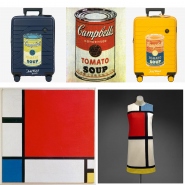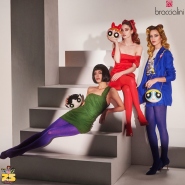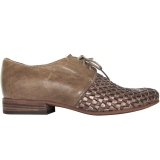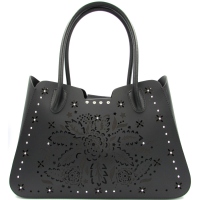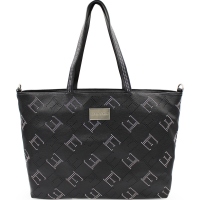When going on a journey, a business trip or moving to another city, we always take the bare essentials. How can we do without them? Now, let's imagine what an inconvenient life it would be without such important accessories as trunks or travel bags. However, there were such times in the human history.
A chest was the first prototype of a suitcase, which appeared in classical times in ancient Egypt about 3.5 thousand years ago. It was a wooden box, decorated with ornamental carvings and paintings with a raised up movable top and large locks.

The ancient Greeks used boxes of a similar design to store their clothes. In everyday usage, they also had portable safe caskets made of wood or bronze with relief designs for transporting and storing jewellery, coins, or family relics. Such caskets were a kind of an up-to-date travelling bag with a locker. The ancient peoples treated a chest like a sacred thing, which kept family histories and secrets. No wonder that it is often mentioned in legends and myths. For example, the ancient Greek history about Pandora – the first woman created at Zeus' behest – tells us about a forbidden box opened by this curious girl, from which misfortune and disasters were released into the world.

In the Middle Ages, such chest types appeared as tower chests – on the main compartment top there was smaller lid, where the most precious things were placed;

and a headrest chest – a small money casket with a sloping top – it was an irreplaceable accessory during medieval merchants' trips, since it contained valuable items and was placed under their heads during sleep.

An interesting fact.
The chest is mentioned in English pirates' famous song: “Fifteen men on a dead man's chest, yo ho ho and a bottle of rum”, which we remember from the book “Treasure Island” by Stevenson. In this novel, the chest for pirates is not just a baggage, but also a symbol of dangerous voyages, secrets, and mysteries. In chests buried on an uninhabited island, pirate Flint hid his treasures, which were searched by the heroes of the book.

The evolution of a chest. Or how a chest turned into a suitcase.
The first prototype of a suitcase appeared in the middle of the XIX century. Its history began in 1837, when Louis Vuitton – a sixteen-year-old son of a carpenter – arrives in Paris and becomes an apprentice of master Marechal, who crafted travel chests and hat boxes.

A talented apprentice quickly mastered the chest-making technique. After working with Marechal for a long time and having acquired sound experience and knowledge, Louis Vuitton decided to start his own business. In 1854, he opened his first workshop in Paris on Rue Neuve des Capucines, which he called “Louis Vuitton: Malletier a Pari”. Thanks to the best materials and finishing quality, the chests by Louis Vuitton became popular among the French elite, and afterwards he became a private packer of Empress Eugenia (the wife of Emperor Napoleon III).

In 1858, Louis Vuitton creates his first evolutionary masterpiece – a flat box that looked like a common modern suitcase. This box was called "Trianon".

It was extremely light and airproof, coated with special waterproof fabric and – for the first time – it could be opened sidewise. Before his invention, travelling boxes (chests) had rounded tops, and it was impossible to conveniently stack them in piles for transportation. However, Trianon suitcases could easily be put on top of one another.


Of course, it was still a long way to do from the first prototype to a convenient and multifunctional trunk that we use today: for example, it had side handles and required 2 porters to carry it. This luxury was too expensive for a common person!
In the middle of the XIX century, when due to the rapid railway construction in the USA, journeys became affordable even to people in a humble station, a need arose to invent a thing that enabled a single person to carry luggage. It was during this period that the first valise appeared (it was also called Sac Voyage – from the French "Bag for Travel"), which was a capacious sack-shaped bag with one or two short handles. The first carpetbags were made of old carpets, and that's where they got their name from.

Unlike a bulky trunk, this bag was light and convenient, but had a disadvantage – it wore out too quickly. Therefore, later such bags were manufactured of leather that was more wear-resistant and prolonged a bag's life.
Gradually, rich people began to use leather carpetbags as well: it was not only an item for carrying necessary personal belongings, but also money. For additional safety of luggage, locks with keys were added to the carpetbags.

An interesting fact.
In the novel “Around the World in 80 Days” written in 1873, Jules Verne mentions the carpetbag, which the main character Phileas Fogg and his servant Passepartout travelled with:
- “We’ll have no trunks; only a carpet-bag, with two shirts and three pairs of stockings for me, and the same for you. We’ll buy our clothes on the way. Bring down my mackintosh and traveling-cloak, and some stout shoes, though we shall do little walking. Make haste!”
Mr. Fogg took the carpet-bag, opened it, and slipped into it a goodly roll of Bank of England notes, which would pass wherever he might go.
“Good! Take this carpet-bag,” handing it to Passepartout. “Take good care of it, for there are twenty thousand pounds in it.”.

Gradually, by the late 19th and early 20th centuries, when huge numbers of people started emigrating from one continent to another, appeared a combined version of a traveling bag and a carpetbag – a small suitcase with hard sides and one handle for carrying it.

Suitcases in united watch catalogue, 1911
After American company Shwayder Brothers was founded in 1910 by entrepreneur Jesse Schweider, the era of an affordable luggage case with innovative details began.

Advertising of Shwayder Brothers trunk
In the 1930s, the company introduced “Samson” suitcase with a wooden base, a solid handle, fabric finishing, and secure locks.

In 1941 – a Streamlite suitcase model with a wooden frame, covered with a special coating made of vulcanized fibre. Later, the company was renamed as Samsonite, and all its products were manufactured under the same brand name, which is still famous today.

An interesting fact.
Arriving at one of London hotels, an American writer and journalist Mark Twain saw a note in the guest registry: "Lord L. with a valet". Twain, who had an extremely uncommon thinking and sense of humour, wrote in turn: "Mark Twain with a trunk".

Ernest Hemingway's "Bookcase" trunk (1923)
.jpg)
A wardrobe trunk Mrs. Donahue (1936)
How a suitcase got its wheels.
In 1972, an employee of United States Luggage Bernard David Sadow and his wife were returning from vacation on Aruba island and could hardly carry two heavy trunks to the Puerto Rico customs control desk. At this moment, a port worker passed them, rolling a cart loaded with luggage. And unexpectedly David Sadow got an idea to create a rolling trunk... After returning home, Sadow whipped up a trolley case prototype by attaching four wheels to the bottom and stretching a strap through a trunk handle. Despite the fact that it was a brilliant idea, luggage manufacturers did not accept it. Bernard David Sadow spent a lot of efforts and energy in vain attempts to start producing his new invention, until he received a positive answer from Macy’s Company.

A wheeled Carry-On with a retractable handle.
A trolley case got its final look, familiar to all modern people, only in the late 1980s, when a pilot of an American airline Northwest Airlines Robert Plath tried to facilitate luggage transportation during regular flights and attached two small furniture wheels to his bag and sewn a pocket to its side that hid a retractable metal handle. In 1989, Robert Plath registered a patent for a “travelling bag with wheels and a retractable handle”. His invention was called Rollaboard. The same year, the former pilot founded his own company Travelpro. A convenient novelty was in incredibly high demand. Only within the first year of its existence, the company earned a million and a half dollars of profit, and in 10 years its sales amounted to 50 million dollars per year.

Appearance and design of a modern carry-on trolley cases, trunks, suitcases and Italian brands.
Italy is famous for its artists and designers. One of the most well-known manufacturers specializing in fashionable and high-tech trunks and travelling bags is an Italian company Bric’s. This brand's products are known for their elegance, high quality of finishing and materials used.

One of the latest trendy novelties presented by Bric’s is Bellaggio collection. This trolley case line is made of durable high-tech polycarbonate Makrolon®, coated with genuine Tuscan leather.

With a double lock: locked with a key and with a code locker with TSA function (this is a lock that if necessary enables unhindered customs inspection by the Transportation Security Administration security service, which has a special universal key to the lock).

A circular zipper is used to fasten the trunks. They are also equipped with four wheels, developed by Japanese technology, which can easily rotate in all directions by 360°. The wheels feature excellent passableness, do not slip, and provide utmost silence and ease of the trunk transportation due to a special rubber coating.

Another novelty! Now, modern trunks contain charging devices for mobile phones and gadgets due to the built-in USB port on the outer side, which connects to a power supply unit with Power Bank battery located inside the trolley.

A really magical luggage case!
For the fans of retro classics and vintage things, an Italian company The Bridge created a special accessory line in the style of the XIX and early XX centuries called “The Bridge Story”: a leather carpetbag, a classic suitcase with straps, a suitcase with a wooden frame coated with leather in the style of the 1930s , an exclusive cigar box, a doctor's bag, a hat box, a wardrobe trunk, and a travelling chest.



In all of these luggage accessories The Bridge finds the perfect combination of the vintage design and cutting-edge materials.
The classic is eternal and unique at the same time. With The Bridge accessories, we return to the roots!






 Online Shop
Online Shop
 Terms and Conditions
Terms and Conditions
 Payments
Payments
 Feedback
Feedback
 Customer Support and Contacts
Customer Support and Contacts
 Discounts
Discounts
 Worldwide customs duties
Worldwide customs duties


 English
English
 Русский
Русский
 Deutsch
Deutsch
 Español
Español
 Français
Français

 +39
+39 info@air-fashion.com
info@air-fashion.com  Enter
Enter
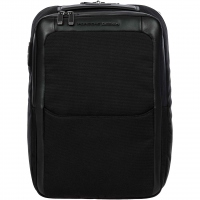
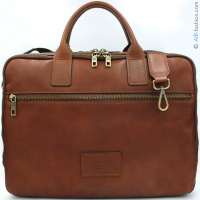


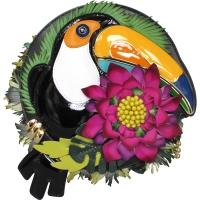


















.jpg)












